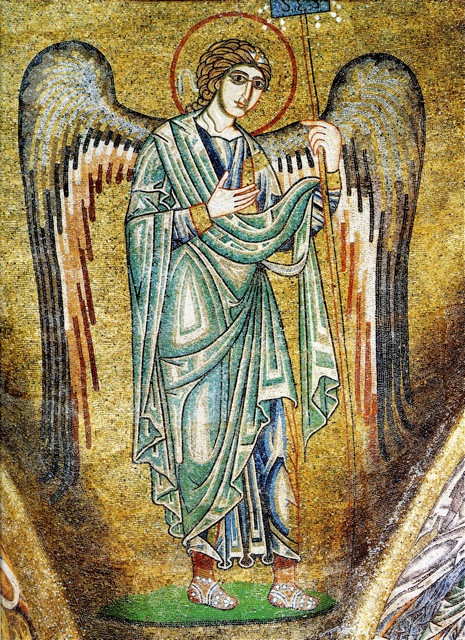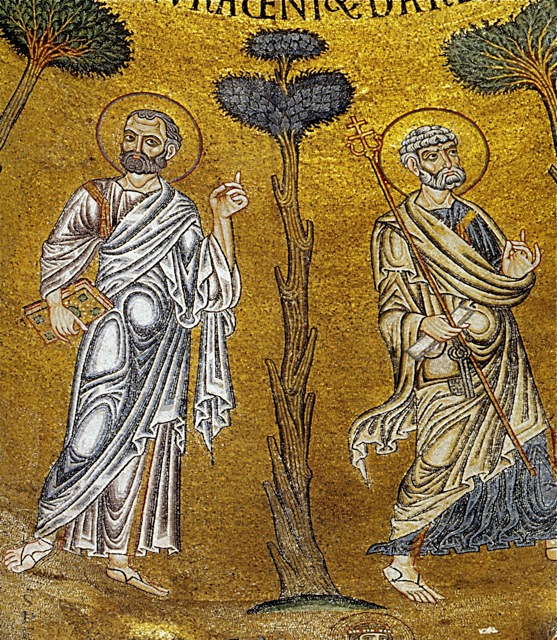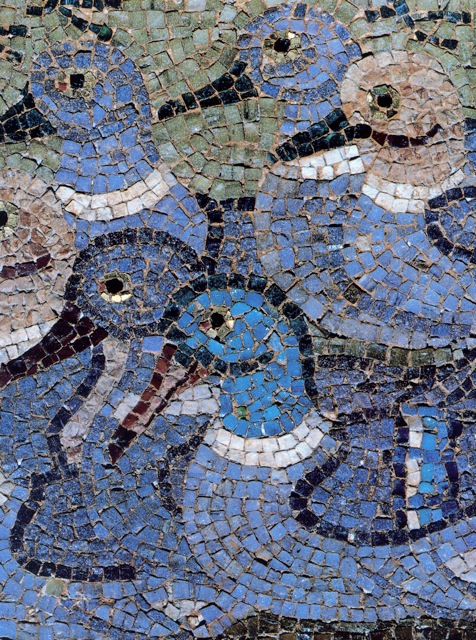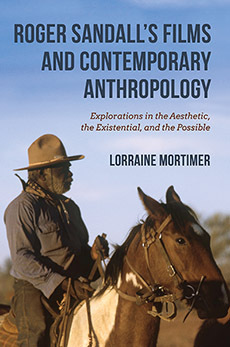Ever been to Ravenna? The church of San Vitale with the mosaics of Justinian and Theodora done around 540-550AD? In the early days of tomography I once wrote about these Byzantine mosaics as an early form of pictorial “sampling” or bitmapping similar to the digitized imagery we have today. It was little more than a literary conceit: but it pointed to something that ramifies in a number of ways.
In the arts you’re led to pointillisme, and the way Seurat and others used discontinuous dots to represent continuous planes and forms and colors. Within philosophy, there’s a connection with coordinate representation as it appears in Descartes: descriptions of matter reduce down and down through an infinity of locational points.
Neurobiology and the physiology of the eye throw up odd things about dots and spaces we see illustrated by the optical illusions circulating on the Web. And eventually one comes face to face with the grain of the universe: all things smooth and homogeneous are found on closer examination to be grainy and heterogeneous, right on down to subatomic levels.
Anyway, I recently discovered that what I’d written about constructing images from tesserae—the miniature tiles, pebbles, fragments of limestone and colored glass along with the gold leaf used as background in Byzantine mosaics—was the merest trifle alongside Ruskin’s description of the ceiling of St Mark’s in Venice.
He begins by providing the environmental and botanical background to a mosaic on one of the church’s cupolas. There we find the apostles on the Mount of Olives, each of them separated by an olive tree. The olive tree, Ruskin writes, is one of the most characteristic and beautiful features of all Southern scenery:
On the slopes of the northern Apennines, olives are the usual forest timber; the whole of the Val d’Arno is wooded with them, every one of its gardens is filled with them, every one of its gardens is filled with them, and they grow in orchard-like ranks out of its fields of maize, or corn, or vine; so that it is physically impossible, in most parts of the neighborhood of Florence, Pistoja, Lucca, or Pisa, to choose any site of landscape which shall not owe its leading character to the foliage of these trees.
The question he wants to examine is how an artist, working in mosaic (and high above the observer in the church), is to represent this foliage. There are problems of scale and color and form for the artist, and of available light for the viewer. The olive tree—
Has sharp and slender leaves of a greyish green, nearly grey on the under surface, and resembling, but somewhat smaller than, those of our common willow.
Its fruit, when ripe, is black and lustrous; but of course so small, that, unless in great quantity, it is not conspicuous upon the tree.
Its trunk and branches are peculiarly fantastic in their twisting, showing their fibres at every turn; and the trunk is often hollow, and even rent into many divisions like separate stems, but the extremities are exquisitely graceful, especially in the setting on of the leaves; and the notable and characteristic effect of the tree in the distance is of a rounded and soft mass or ball of downy foliage.
This botanical description brings us directly to the 11th century artist’s task: how to manage all this in the cupolas of St Mark’s. Ruskin notes that the old Byzantine mosaicist began his work with an enormous disadvantage. The artwork was
to be some one hundred and fifty feet above the eye, in a dark cupola; executed not with free touches of the pencil, but with square pieces of glass; not by his own hand but by various workmen under his superintendence; finally, not with a principal purpose of drawing olive-trees, but mainly as a decoration of the cupola.
There is to be an olive-tree beside each apostle, and their stems are to be the chief lines which divide the dome. He therefore at once gives up the irregular twisting of their boughs hither and thither, but he will not give up their fibres. Other trees have irregular and fantastic branches, but the knitted cordage of fibres is the olive’s own.
Again, were he to draw the leaves of their natural size, they would be so small that their forms would be invisible in the darkness; and were he to draw them so large as that their shape might be seen, they would look like laurel instead of olive…
Lastly, comes the question respecting the fruit. The whole power and honour of the olive is in its fruit; and, unless that be represented, nothing is represented. But if the berries were coloured black or green, they would be totally invisible; if of any other colour, utterly unnatural, and violence would be done to the whole conception.
There is but one conceivable means of showing them, namely, to represent them as golden. For the idea of golden fruit of various kinds was already familiar to the mind, as in the apples of the Hesperides, without any violence to the distinctive conception of the fruit itself. So the mosaicist introduced small round golden berries into the dark ground between each leaf, and his work was done.
I once had a room close by St Mark’s. It was winter and it rained. Water cascading from roofs fell splashing onto the pavings below, blending at night with the cries and singing of people returning from evenings out, and their quickly echoing steps, and the hourly striking of a bell. But to my shame I recall little of the basilica. Apparently I’m not alone. Ruskin comments on “careless travellers” who pass by unheeding and oblivious. I guess I was one of them. Don’t even remember Noah’s ark and the ducks.




 An Australian writer living in Sydney, Roger Sandall is the author of The Culture Cult (2001), a study of romantic primitivism and its effects. His work has appeared in a number of places including Commentary, The American Interest, Encounter, The New Criterion, The American, Sight and Sound, Quadrant, Art International, The New Lugano Review, The Salisbury Review, Merkur, Mankind, Visual Anthropology, and Social Science and Modern Society.
An Australian writer living in Sydney, Roger Sandall is the author of The Culture Cult (2001), a study of romantic primitivism and its effects. His work has appeared in a number of places including Commentary, The American Interest, Encounter, The New Criterion, The American, Sight and Sound, Quadrant, Art International, The New Lugano Review, The Salisbury Review, Merkur, Mankind, Visual Anthropology, and Social Science and Modern Society.